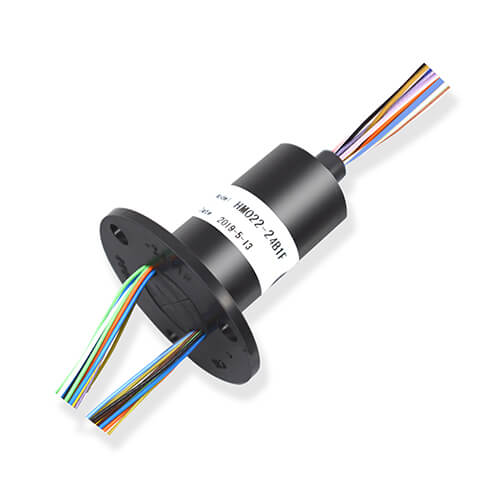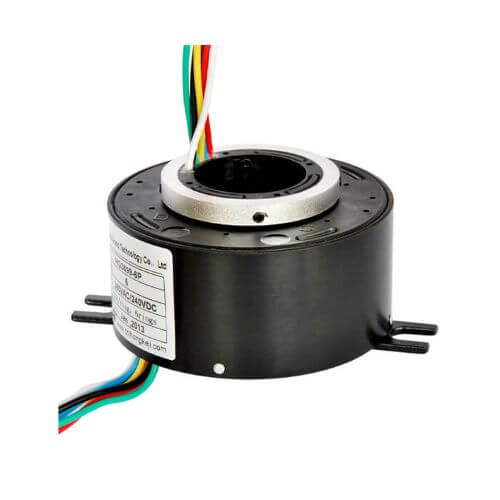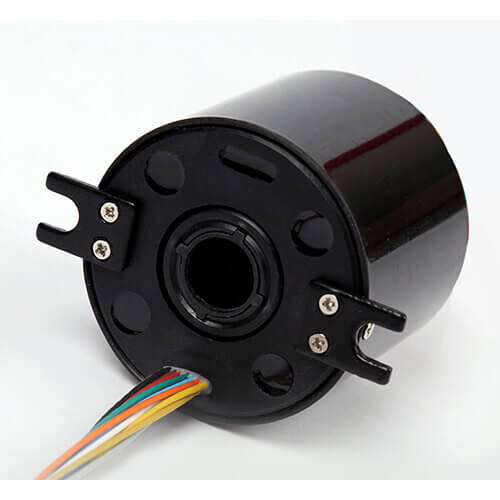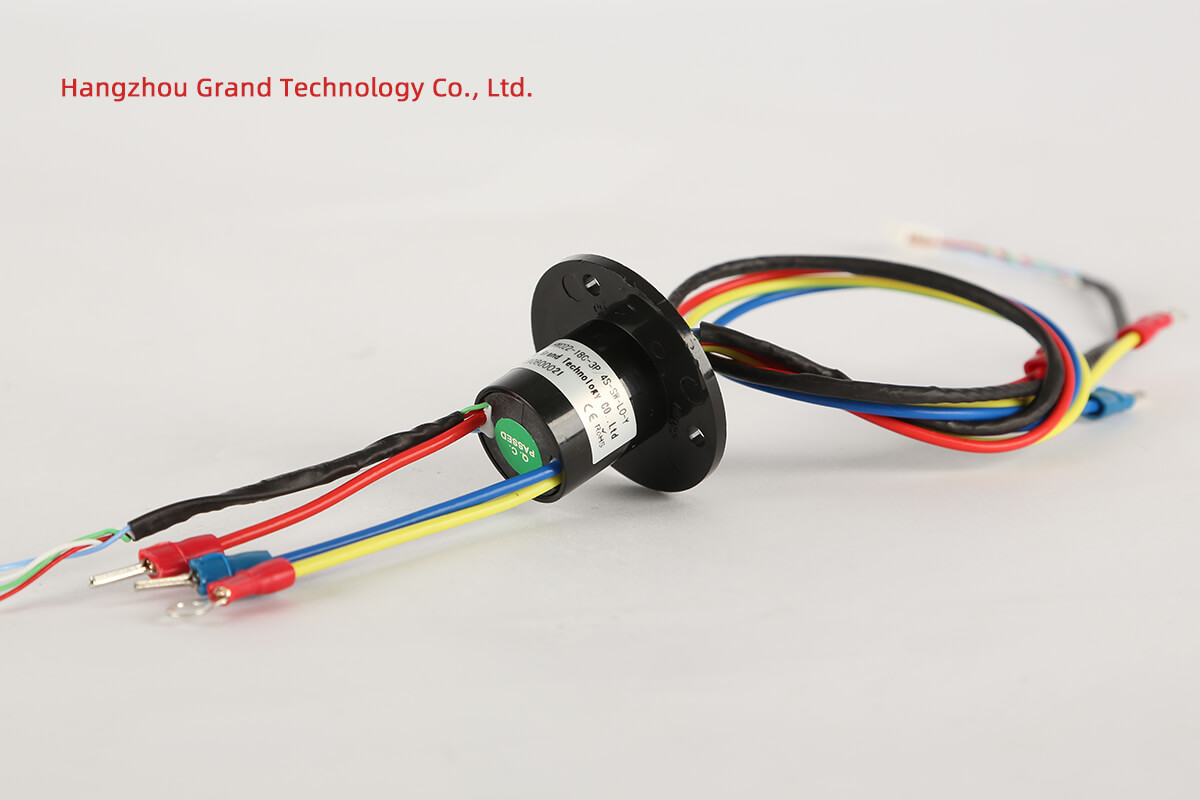Virtual Reality (VR) is a rapidly expanding field, offering immersive experiences that transform industries from entertainment to medical training. Standing as a critical component at the heart of this revolution is a device known as the VR slip ring.
Essentially, VR slip rings are electro-mechanical devices that provide an electrical connection between stationary and rotating components. They play a pivotal role in ensuring continuous, uninterrupted data and electrical transmission, even while parts in a system are rotating. This is particularly integral in VR applications where smooth, consistent data flow is required to maintain immersive experiences.
In the contemporary age of technology, the importance of VR slip rings is underscored by the growing adoption of VR across a myriad of industries. Imagine the sensation of turning your head around in a virtual world, with no lag or glitch interrupting your exploration; that seamless interactivity hinges on the robust functionality of VR slip rings.
Additionally, as businesses strive to keep up with technological advancements and maintain a competitive edge, VR slip rings are becoming instrumental in enabling state-of-the-art tools and technologies such as robotic arms, wind turbines, and of course, VR systems, where continuous rotation is needed. Hence, understanding VR slip rings’ operation, applications, and intrinsic qualities is crucial for anyone involved in fields related to technology, robotics, or VR systems. In the subsequent parts of this guide, we will delve deeper into these aspects, giving you a comprehensive overview of VR slip rings.
Design and Functionality of VR Slip Rings
At their heart, VR slip rings are a marvel of engineering, a testament to our capability to manipulate and coordinate complex technological systems seamlessly. The design of VR slip rings is centered around the core needed to facilitate the transmission of electrical signals and power from stationary components to rotating parts while sustaining smooth and continuous rotation.
Typically, a VR slip ring consists of two primary sections – the stationary part, often referred to as the stator, and the rotating part, known as the rotor. The stator houses the electrical connections that need to be passed on to the rotating interface or rotor. The rotor and stator sections are designed to come into contact in a way that allows for low-friction rotation while maintaining excellent conductivity for signal and power transmission. This intricate balance between friction reduction and conductivity is achieved using high-quality conductor materials and careful precision engineering.
In terms of functionality, VR slip rings work by connecting the stationary systems to the rotating interfaces through brushes. Electrical signals or data inputs are fed through these brushes, which maintain a point of contact with the rotor. As the rotor turns, the electrical connection remains constant, thanks to the coordinated movement of the brushes. This ensures a continuous flow of electricity or data, despite the dynamic movement of the components.
The benefits of VR slip rings are manifold. They provide much-needed flexibility in applications that involve rotation while maintaining electronic connections. Imagine a VR headset, wherein the user’s movements are swift and constant, yet the visual data provided by the screen needs to remain uninterrupted and lag-free. This is made possible by VR slip rings, which guarantee a consistent flow of data regardless of the headgear’s constant rotational movement.
Moreover, the use of VR slip rings extends beyond VR applications, making them significant in various technological fields — from wind turbines that need to rotate freely while generating electricity, to medical equipment that demands constant rotation while maintaining necessary connections for performing health diagnostics. Thus, VR slip rings stand as an essential part of many modern electronic devices, acting as the silent enablers of technological marvels and wonders.
Different Types of VR Slip Rings
Just as our technological world is diverse and versatile, so too is the market for VR slip rings – offering a variety of slip ring types optimized for specific applications. The following are some of the most common types, their unique features, and the applications they are best suited for:
Capsule Slip Rings

As the name suggests, capsule slip rings are compact and encapsulated within a small casing. They are designed to accommodate space limitations without compromising functionality. Despite their small size, they ensure high precision, low friction, and minimum electrical noise. They offer a low torque which aids in smooth rotation and low contact pressure which is vital in maintaining the longevity of the brush and contact surface. Given these features, capsule slip rings are ideal for use in compact systems like VR headsets, where space is a premium, and smooth, high-fidelity signal transmission is essential.
Through-Bore Slip Rings

Through-bore slip rings, uniquely, feature a central hole or “bore” through their central axis. This design allows additional components such as cables, shafts, or even other types of connectors to pass through them. They’re versatile and come in different diameters to accommodate a variety of mounting requirements. Their application is broad, including use in wind turbines, video surveillance systems, or any system requiring a mix of rotational freedom and multifunctional integration.
High-Speed Slip Rings

Designed to cope with high-speed rotations, these slip rings have an extensive range of capabilities regardless of high-frequency operations. They can maintain robust performance even under fast rotational situations, ensuring smooth data transmission without signal degradation or loss. High-speed slip rings are best used in applications with high RPM requirements, such as certain kinds of medical machinery or high-intensity VR gaming scenarios where seamless data transmission at high speeds is a prerequisite.
Understanding these different types of VR slip rings and their respective specialties allows one to make the best choice based on the specific requirements of their application — whether it be space constraints, versatility needs, or high-speed demands. In the dynamic world of technology and innovation, there’s a slip ring out there designed to meet almost every conceivable rotational and connectivity requirement.
Factors to Consider When Purchasing VR Slip Rings
Making the right choice in purchasing VR slip rings is more than just selecting the one that fits the budget. To ensure optimal performance and longevity, several essential factors need to be taken into consideration:
- Durability: One of the most important factors to consider is the durability of the VR slip ring. An excellent slip ring is made from high-quality, robust materials that can withstand high levels of friction and resist wear and tear effectively. Since slip rings are often integral to a system’s performance, a failure could lead to significant downtime and repair costs, thus a durable slip ring will provide the reliability your system needs.
- Smoothness of Rotation: A smooth and consistent rotation is vital for precise data transmission and power provision. The rotation of the slip ring should be seamless and without jerks or interruptions, which could lead to signal loss or inconsistency. This is particularly crucial in applications such as VR systems, where smooth data transmission is key for a lag-free and immersive experience.
- Transfer Stability: Alongside smooth rotation, the stability of the ring’s transfer capabilities is paramount. A good-quality slip ring maintains a reliable, continuous transfer of power and electrical signals between rotating and stationary components. Any inconsistencies in the transfer can hamper the functioning of the system, especially in data-dependent applications like VR.
- Service Life and Maintenance Requirements: The ultimate value of your slip ring choice will also depend on its service life and maintenance requirements. A high-quality slip ring should have a prolonged service life and require minimal maintenance. Frequent need for replacements or repairs not only increases costs but can also lead to significant system downtime. Therefore, it’s important to understand the service life of the slip ring, the level of maintenance it might require, and how easily it can be serviced or replaced.
- Integration and Space Requirements: The VR slip ring’s size and how well it can be integrated into your device or system a critical factors. The slip ring should meet your space requirements and be adaptable enough to integrate smoothly into your system. A mismatch here could lead to significant installation difficulties and impact the overall functioning of the device.
Taking into account these core factors – durability, smoothness of rotation, transfer stability, service life, and the potential for seamless integration – will lead to a sound and informed decision, ensuring you select the right VR slip ring for your specific application and needs. A holistic approach to procurement will pay dividends in terms of system performance, reliability, and cost-effectiveness.
Technological Advancements in VR Slip Rings
The ever-evolving landscape of technology doesn’t spare any segment, and VR slip rings are no exception. The continuous push for innovation and optimization has led to the creation of some fascinating advancements in VR slip ring technology. Just as the demands and applications of this technology broaden, the research and innovation in this field keep pace, contributing to the improved performance and reliability of VR slip rings.
- Integration of Fiber Optic Rotary Joints (FORJ): One significant advancement has been the integration of Fiber Optic Rotary Joints (FORJs) in slip rings. By channeling light instead of an electrical current, this technology allows for higher data transmission speeds, greater resistance to electromagnetic interference, and better overall signal integrity. Data transmission through fiber optics is virtually lossless, contributing to the flawless immersive experience necessary for optimal VR function.
- Improved Brush Materials: Ongoing developments in brush materials and design have pushed the boundaries of slip ring technology. The use of precious metals like gold for brushes has become more commonplace. Gold has a low contact resistance and high conductivity, resulting in an improved flow of data and power. Additionally, it’s highly resistant to corrosion, thus extending the lifespan of the overall system.
- Enhanced Sealing for Outdoor Applications: Enhanced sealing technologies, specifically for VR slip rings deployed in outdoor environments, have become more advanced. These improvements help shield the components from dust, moisture, and other environmental elements, ensuring stable performance even in harsh conditions.
These technological advancements have drastically improved the performance and reliability of VR slip rings. The integration of FORJ, for instance, means that huge volumes of data can now be transferred instantaneously and without interference. Gold brushes have resulted in more consistent power and data transmission, alongside lower maintenance requirements.
Moreover, the improved environmental resilience of slip rings, thanks to enhanced sealing technologies, ensures optimal function across a range of applications and environments. As a result, today’s VR slip rings are more efficient, reliable, durable, and effective in their ability to maintain electrical contact between stationary and rotating interfaces.
As technology advances, we can expect to see even further improvements in VR slip ring technology, making what is already an impressive technological touchstone even more efficient and effective in its varied applications.
Common Concerns About VR Slip Rings
While VR slip rings are an integral part of many systems, virtually ensuring seamless and effective data and power transmission, prospective users often have certain reservations or concerns before investing in them. Some of these concerns revolve around data transmission, maintenance, and durability of VR slip rings:
- Data Transmission Issues: Since the primary function of a VR slip ring is to facilitate uninterrupted power and signal transmission between rotating and stationary interfaces, any issues in this context can be a major concern. Users worry about potential signal loss or degradation due to poor conductivity or design deficiencies. However, modern VR slip rings are designed to minimize these issues significantly. The introduction of Fiber Optic Rotary Joints (FORJ) and the use of precious metals like gold for brushes support consistent, high-speed data transmission.
- Maintenance Requirements: Maintenance and serviceability can be a significant concern for potential users, as the constant need for upkeep can lead to system downtime and subsequently increased costs. High-quality VR slip rings, however, are built with materials and designs aimed at reducing wear and tear and subsequently, lowering maintenance requirements.
- Durability: The lifespan and durability of the VR slip rings are another commonly raised concern. Users strive for a product that can withstand the demands of their application for a prolonged period of time. Advances in materials and technology have contributed to an increased lifespan for modern VR slip rings, mitigating this concern to a certain degree.
- Cost Inefficiency: While not a direct issue with the product, cost-effectiveness is a common concern for users. The balance between cost and quality is crucial. Though high-quality VR slip rings may come with a higher upfront cost, they tend to be more cost-effective in the long run due to their durability and reduced maintenance needs.
- Installation and Integration: Some users may be concerned about the ease of installation and integration of the slip ring in their existing systems. With varying size specifications and design types available in the market, choosing a suitably adaptable slip ring might seem daunting. Fortunately, manufacturers nowadays offer a wide range of VR slip rings to choose from, making it easier to find one that fits seamlessly into a given system.
These concerns, while valid, can often be assuaged by taking time to understand the advancements in the latest slip ring technology and selecting a product that is ideally suited to their specific requirements. It’s recommended always to choose reputable manufacturers and suppliers who can provide high-quality products and reliable after-sales support.
Conclusion
Understanding the features and considerations when selecting a VR slip ring is essential for the success of your project. By examining aspects such as design, durability, performance, and technological advancements, you can choose the perfect VR slip ring for your specific application.
Always ensure you select a reliable manufacturer or supplier to guarantee a high-quality product and support throughout the product’s life cycle. With the right VR slip ring in place, you will enjoy seamless experiences and optimal functionality in various applications.
FAQs About VR Slip Rings
VR Slip Rings are an essential component in many data and power transmission applications, including virtual reality systems. However, potential users or newcomers in this field may have various questions about VR slip rings. Let’s address some of the most frequently asked ones:
Q1: How does a VR Slip Ring function?
A: A VR slip ring operates as an electromechanical device that allows uninterrupted transmission of power and electrical signals from a stationary component to a rotating one. This ensures smooth operation in applications such as VR systems, radar systems, etc., where rotation is a necessary element.
Q2: What materials are commonly used in VR Slip Rings?
A: Various types of metals are used in VR Slip Rings, but the most common include copper, gold, silver, and graphite for the brushes and rings. The choice of material heavily depends on the application, as each material comes with its unique pros and cons. For example, gold is renowned for its outstanding conductivity and minimal contact resistance.
Q3: Why is the lifespan of a VR Slip Ring important?
A: The lifespan of a VR slip ring is critical because a premature failure can lead to significant downtime and repair costs in the system it’s supporting. A slip ring with an extended lifespan offers reliability & durability for longer periods, reducing replacement & maintenance costs. Therefore, it’s essential always to consider the product’s lifespan before purchasing.
Q4: What impacts the data transmission quality in a VR Slip Ring?
A: Many factors can impact the data transmission quality of a slip ring. These include the chosen materials’ conductivity, the design of the brush and ring interface, the level of contact resistance, and the presence of disruptive elements like dust or moisture. Recent advancements, such as Fiber Optic Rotary Joints (FORJ), have considerably enhanced slip ring data transmission quality.
Q5: How important is it to correctly install a VR Slip Ring?
A: Correct installation of a VR slip ring is critical as incorrect installation can result in reduced performance, increased wear & tear, or even system failure. It can also affect the slip ring and dependant system’s lifespan. For optimal performance, installation should follow the manufacturer’s guidelines or carried out by a trained professional.
Q6: Can VR Slip Rings be customized?
A: Yes, VR Slip Rings indeed are often customizable. Many manufacturers offer customization services to tailor-fit the product to the specific needs of a client’s application. Variables like dimension, signal types, channels, current ratings, and materials can be adjusted to suit particular requirements or specifications.
In a nutshell, understanding how VR slip rings function, what impacts their performance, and how to correctly install and maintain them, helps you better utilize them in your system or application. Always remember to consult with your manufacturer or supplier to ensure that you’re getting the right product tailored specifically to your needs.
See What We Can Do

